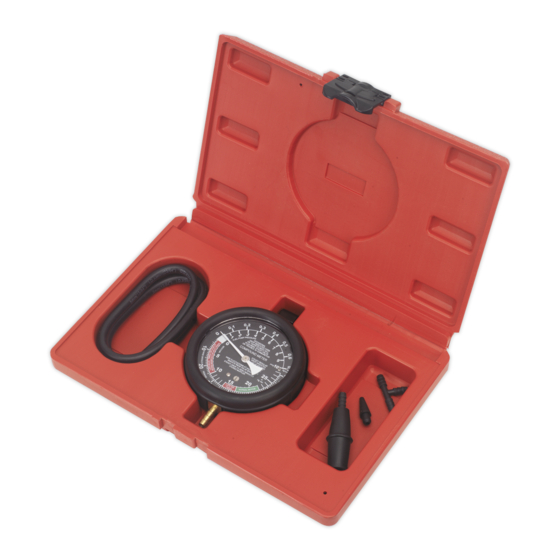
Advertisement
Quick Links
Thank you for purchasing a sealey product. manufactured to a high standard, this product will, if used according to these
instructions, and properly maintained, give you years of trouble free performance.
IMPORTANT: PLEASE READ THESE INSTRUCTIONS CAREFULLY. NOTE THE SAFE OPERATIONAL REQUIREMENTS, WARNINGS & CAUTIONS. USE
THE PRODUCT CORRECTLY AND WITH CARE FOR THE PURPOSE FOR WHICH IT IS INTENDED. FAILURE TO DO SO MAY CAUSE DAMAGE AND/OR
PERSONAL INJURY AND WILL INVALIDATE THE WARRANTY. KEEP THESE INSTRUCTIONS SAFE FOR FUTURE USE.
Refer to
Wear eye
instructions
protection
1. saFeTy
observe standard workshop safety procedures when using the test gauge.
9
Wear safety eye protection and protective clothing. Avoid touching eyes while working with petrol.
9
Have fresh water nearby in case petrol contacts skin, clothing or eyes.
9
Remove loose personal items such as rings, bracelets, necklaces, ties and contain long hair.
9
ensure hands, clothing are clear of fan blades and other moving or hot parts of engine.
9
Keep the work area clean and uncluttered and ensure there is adequate lighting.
9
Maintain correct balance and footing. Ensure the floor is not slippery and wear non-slip shoes.
9
Keep children and unauthorised persons away from the working area.
9
ensure that connections for testing the fuel pump are secure and free from leaks.
9
WarNING! DO NOT use test gauge on any vehicles other than those with carburettor fuel systems.
‰
DO NOT smoke or allow a spark or flame in and around the vehicle.
8
DO NOT dismantle the test gauge. The test gauge must be checked by qualified service personnel only.
8
DO NOT get tester wet or use in damp or wet locations or areas where there is condensation.
8
DO NOT use the tester for any purpose other than that for which it is designed.
8
DO NOT operate the tester if damaged.
8
When not in use store tester in a safe, dry, childproof location.
9
2. INTrODucTION
Ø80mm Gauge with protective rubber bumper and hanging hook. Checks for leaks in fuel line, vacuum chokes and heating. Also suitable for
diagnosing valve problems. Includes long flexible hose and adaptors. Supplied in storage case.
3. OPeraTION
3.1.
Vacuum TesT.
3.1.1.
Use the supplied adaptors to connect gauge hose as close to the inlet manifold as possible, ensure that the hose is not kinked.
Should an engine have two inlet manifolds carry out separate tests on each manifold.
3.1.2.
Start engine, if required adjust idle speed to obtain a smooth tick over.
3.1.3.
If the gauge needle remains steady with a reading between 17 and 22 inHg, the engine is in good condition.
3.1.4.
If the gauge drops back about 4 inHg on the dial, this would indicate sticky valves, disconnect the vacuum hose and spray
penetration oil into the manifold to lubricate the valves.
3.1.5.
If the needle consistently drops, this would indicate that the valve clearances are too tight or that a valve has burnt out.
3.1.6.
If the needle pulsates rapidly when the rpm is increased, this indicates that the valve springs may be weak.
3.1.7.
If the needle pulsates rapidly at idle and steadies out when the rpm is increased, indicates that the valve guides are worn or loose.
3.1.8.
If the needle is slow to drop back after the engine rpm has been increased several times in succession, would indicate that the
exhaust system may be partially blocked.
3.1.9.
If the gauge indicates less than 10 inHg, this would indicate that the valve timing is late.
3.1.10.
To check the choke, close the throttle and turn the engine over using the starter motor, the gauge should rise quickly to 22 inHg.
If the gauge remains at a low reading or 3 to 6 inHg then the throttle may not be fully closed or there may be an air leak in the inlet
manifold.
NOTe: Gauge readings will vary with altitude, at sea level the approximate reading will be 19.5 inHg, for every 1000ft above sea level the
vacuum gauge will drop by 1 inHg. For instance at 2000ft the reading will be 17.5 inHg.
3.2.
Fuel PumP Vacuum TesT. (Mechanical fuel pumps only).
3.2.1.
disconnect the inlet pipe to the fuel pump and plug the hose to avoid spillage.
3.2.2.
Connect the vacuum pipe to the inlet connection of the fuel pump.
3.2.3.
Start the engine, if the gauge indicates approximately 10 inHg the pump is in good condition.
3.3.
Fuel PumP Pressure TesT. (Mechanical fuel pumps only).
3.3.1.
disconnect the fuel pipe from the outlet of the fuel pump.
3.3.2.
Connect the gauge hose to the outlet side of the fuel pump.
3.3.3.
Start the engine, there should be enough fuel in the carburettor to allow the engine to run for about two minutes.
3.3.4.
Check the pressure reading against manufacturers specifications for that model.
3.3.5.
The fuel pump pressure should remain fairly constant for several minutes after the engine has stopped. If pressure reduces quickly
check the fuel pump diaphragm and seals for leaks.
© Jack Sealey Limited
Vacuum & Fuel PumP Pressure TesT
GauGe seT
Model no:
Wear protective
Wear safety
gloves
footwear
Original Language Version
Vse952
Wear protective
clothing
VSE952 Issue 2 (HF) 07/03/19
Advertisement

Summary of Contents for Sealey VSE952
- Page 1 Vse952 Model no: Thank you for purchasing a sealey product. manufactured to a high standard, this product will, if used according to these instructions, and properly maintained, give you years of trouble free performance. IMPORTANT: PLEASE READ THESE INSTRUCTIONS CAREFULLY. NOTE THE SAFE OPERATIONAL REQUIREMENTS, WARNINGS & CAUTIONS. USE THE PRODUCT CORRECTLY AND WITH CARE FOR THE PURPOSE FOR WHICH IT IS INTENDED.
- Page 2 Important: no liability is accepted for incorrect use of this product. Warranty: Guarantee is 12 months from purchase date, proof of which is required for any claim. sealey Group, Kempson Way, suffolk Business Park, Bury st edmunds, suffolk. IP32 7ar 01284 757500 01284 703534 sales@sealey.co.uk...







